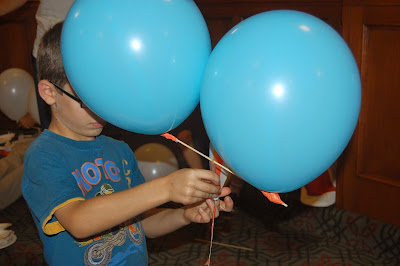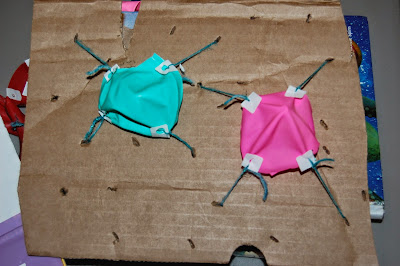Playing a Record Without a Turntable
Monday's hands-on science program, "The Science Behind Recording Music," challenged tweens to come up with several iterations of a gramophone that could play the sound stored on a vinyl record with only their hands to power it.
First, tweens learned about the history of sound recording and its great inventors, from Leon Scott to Alexander Graham Bell, to Edison to Berliner. I engaged the kids in some fun questions to test their critical thinking skills, like: "How many grooves are on each side of a record?" and "How many times a second would a record turn if it's turning at 33 1/3 revolutions per minute?"
Here are my slides from that presentation:
And here is the video I created to give them a sample of what they would be doing:
Then we started spinning records of our own. We made a gramophone out of a tin can, aluminum foil, and a pin, and lowered the pointy end of the pin onto the record while we spun it to see if we could hear sound. Our records we spun by sticking thick rounded pencils through the holes in the center. With the pin scratching the groove, it should pick up the vibrations from the groove of the record and transfer those vibrations to a diaphragm (the tinfoil) and then amplify them (with the cylinder).
We tried latex instead of tinfoil, and funnels instead of cans, and finally a simple paper cone (which was the lightest version and therefore the most effective!). Kids had to write down observations and notes about how each machine worked and rate its effectiveness in loudness and clarity.
I have to give a lot of credit to the person at Science Buddies who came up with this project idea on which I based a lot of my program, especially the observation sheet!
Here are some of my photos from the program:
I took tons of videos of the kids playing their records. Here's the mashup I made out of them:
If you do this as a project with your kids or students, let me know how it goes!
First, tweens learned about the history of sound recording and its great inventors, from Leon Scott to Alexander Graham Bell, to Edison to Berliner. I engaged the kids in some fun questions to test their critical thinking skills, like: "How many grooves are on each side of a record?" and "How many times a second would a record turn if it's turning at 33 1/3 revolutions per minute?"
Here are my slides from that presentation:
And here is the video I created to give them a sample of what they would be doing:
Then we started spinning records of our own. We made a gramophone out of a tin can, aluminum foil, and a pin, and lowered the pointy end of the pin onto the record while we spun it to see if we could hear sound. Our records we spun by sticking thick rounded pencils through the holes in the center. With the pin scratching the groove, it should pick up the vibrations from the groove of the record and transfer those vibrations to a diaphragm (the tinfoil) and then amplify them (with the cylinder).
We tried latex instead of tinfoil, and funnels instead of cans, and finally a simple paper cone (which was the lightest version and therefore the most effective!). Kids had to write down observations and notes about how each machine worked and rate its effectiveness in loudness and clarity.
I have to give a lot of credit to the person at Science Buddies who came up with this project idea on which I based a lot of my program, especially the observation sheet!
Here are some of my photos from the program:
I took tons of videos of the kids playing their records. Here's the mashup I made out of them:
If you do this as a project with your kids or students, let me know how it goes!










Comments
Post a Comment